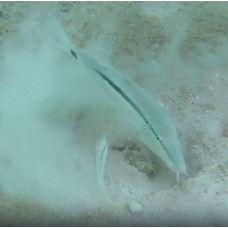Latin name
Parupeneus barberinus
Other name
Parupeneus barberinus
Identification
The body is elongated, slightly compressed at the sides. The upper profile is straight. The mouth is small, the upper jaw reaching only to a vertical line halfway to the beginning of the eye. The teeth on both jaws are arranged in a single row, sparsely sessile, conical in shape. There are 26-32 gill stamens on the first gill arch. The eyes are small. There are 27-28 scales on the lateral line. Two chin antennas, the length of which is less than the length of the head and equal to the length of the snout plus the diameter of the eye.
Features of fish fins
The first dorsal fin has 8 hard rays, the first barb being very short, and the second dorsal fin has 1 barb and 8 soft rays. The anal fin has 1 barb and 7 soft rays. The last ray in the second dorsal and anal fins is equal to or slightly longer than the penultimate ray. Pectoral fins have 16-18 soft rays, most commonly 17. The caudal fin is forked.
Fish colouring
The body is whitish. A black or dark brown band runs from the upper lip through the eye and down the back to the posterior part of the second dorsal fin. The body above the band is yellow or yellowish grey. The edges of the scales are greyish or reddish brown. A large (larger than the diameter of the eye) round black spot is located in the centre of the caudal peduncle. There are interspersed diagonal stripes of pale blue and brownish-yellow from the eyes. There are 1 or 2 parallel blue lines on the cheeks. In deeper water individuals, the body is reddish; the stripe running down the body and the patch on the caudal peduncle may be red.
Distribution
The dash-and-dot goatfish is the most abundant species in its genus. It is widespread in tropical and subtropical waters of the Indo-Pacific region. Its range extends from the Red Sea and Gulf of Aden along the coast of East Africa to the south of South Africa. It extends eastwards to the islands of Micronesia and the Tuamotu. Not found off the Hawaiian Islands. In the western Pacific, from southern Japan to New Caledonia and New South Wales.
Habitat
Marine benthic fishes. They live in coastal waters near coral and rocky reefs. They are found at depths of up to 100 metres.
Size
The maximum body length of these fish is 60 cm, usually up to 30 cm. The body height is 3.3-3.7 times the standard body length. The snout is long and 1.5-2.1 times the length of the head.
Behavior
Adults are solitary or form small groups. Juveniles are usually found in small schools in thickets of underwater vegetation.
Food and feeding habits
Dash-and-dot goatfish hunt over sandy and rocky bottoms. They use their chin tendrils to locate prey. They often retrieve prey from the sand by almost burying themselves in it. Diet consists of benthic invertebrates such as crabs, shrimps, polychaetes, sipuncula, brachiopods, gastropods, isopods; occasionally small fish are found in stomachs.
Reproduction
The main spawning season in the Gulf of Aqaba is from May to August for females and from May to June for males.
Fishing
This species is a local artisanal fishery throughout its range.
Relationship with a person
Harmless.
| Classification | |
| Phylum | Chordata |
| Class | Actinopterygii |
| Squad | Syngnathiformes |
| Family | Mullidae |
| Genus | Parupeneus |
| Species | P. barberinus |
| Features | |
| Conservation status | Least Concern |
| Habitat | Pelagic |
| Life span, years | No information |
| Maximum body weight, kg | No information |
| Maximum length, cm | 60 |
| Sailing speed, m/s | No information |
| Threat to people | Edible |
| Way of eating | Predator |
Dash-and-dot goatfish
Tags: dash-and-dot goatfish


